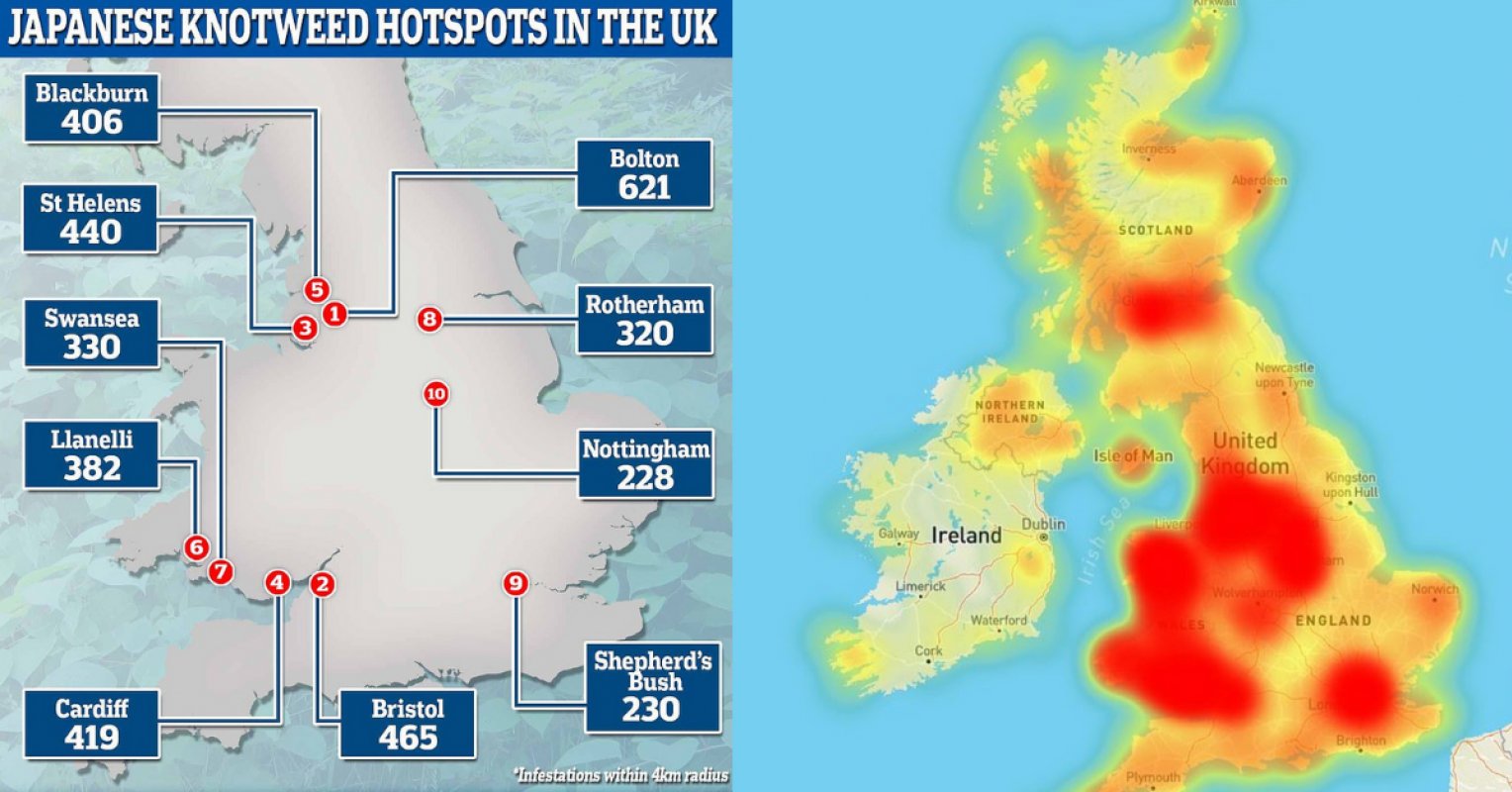作为英国最具破坏性的植物之一,源于日本的蓼科杂草 ——日本虎杖(Japanese Knotweed)因为生长能力太强,经常会造成房屋(House)因此损坏,甚至贬值。一旦受到虎杖入侵,楼价就会下跌,平均下跌10%。目前,英国约有十分之一的房屋(Houses)受到虎杖的影响,导致英国楼价合共下跌约200亿英镑。
只需要1个月的时间,日本虎杖就能生长到 1 米高。夏季生长极速,于 5 月至 7 月期间的每一天,都可以生长 10 厘米,最高时可达到 3 米。相比杂草,虎杖非常难被清除,其根部生长更快,甚至可以深入地底 5 米,横向扩散 7 米以上。如果根没有连根拔起,一些细小的根可以在地底下潜伏 10 年,于合适的时机又会生长出来,通常业主自己很难彻底清理,需要聘请专业人士。
日本虎杖具有超强的穿透能力,能从水泥板或者砖缝中生穿出来,其强壮的根茎将裂缝撑大,对建筑物造成破坏。近日,专门清除入侵植物的英国公司Environet,公布了一份报告,根据其收集的超过 5.4 万次各地报告出现日本虎杖的次数,统计出受日本虎杖影响最严重的地区。
Do YOU live in one of Britain's Japanese knotweed hotspots? Interactive map shows where invasive plant that can grow through bricks and foundations is flourishing
- EXCLUSIVE: A stunning interactive map reveals Britain's Japanese knotweed hotspots
- The plant is very strong and can break through brick, concrete and walls and decreases house prices by 10%
- Data from removal experts reveals around one in 20 houses in Britain is affected by the plant
- Bolton is the worst affected place in the country, followed by Bristol, St Helens, Cardiff and Blackburn
Japanese knotweed is a devastating invasive plant which can break through concrete, bricks and mortar, and new data reveals Bolton is the worst affected place in the UK.
The North West of England is one of the hardest hit parts of the country, with three places — Bolton (first), St Helens (third) and Blackburn (fifth) — among the ten most plagued locations.
Wales and the South West have also been hit hard, with Bristol (2), Cardiff (4), Llanelli (6) and Swansea (7) all in the ten worst affected places.
According to Environet, a company which specialises in the removal of invasive plants like bamboo and Japanese knotweed, the top ten is rounded out by Rotherham in eighth, Shepherd's Bush in ninth and Nottingham in tenth.
The company has built an interactive heat map called Exposed which collected information on more than 54,000 infestations.
Users can browse the map to see how many infestations have been reported within a 4km radius (2.5miles) of any location in the UK, or can search by postcode.
Japanese knotweed is exceptionally strong and its roots are capable of growing through concrete, drains, mortar, brick and even cavity walls.
The weed is incredibly hard to control, as its underground roots grow stronger and faster than the above-ground plant which is visible to gardeners.
A study by scientists at Swansea University in 2018 found the plant is impossible to manage with standard measures. After 19 different attempts, they failed to control it.
Homeowners are unable to control the spread of the plant themselves, with expert help needed in order to eradicate it once it takes root.
It hibernates throughout winter but exits its phase of dormancy in the spring, growing again in March. This growth phase can be easily spotted as distinctive red shoots which look like asparagus emerge.
Other telltale signs of the plant are its distinctive shield-shaped leaves, pretty white flowers which bloom in the summer, and pink-flecked stems.
The plant grows rapidly in the summer months, surging around four inches (10cm) every day between May and July until it reaches a height of up to 10ft (3metres).
The plant is native to the Far East and was brought to Kew Gardens in the 1840s for its beautiful flowers but it grew out of control and has now spread across the British Isles.
The Government estimates it would now cost £1.5bn to clear the UK of knotweed.
Its destructive ability means it can be a nightmare for homeowners as it not only poses a structural risk but reduces a property's value by around ten per cent.
Retrieved from: https://www.dailymail.co.uk/sciencetech/article-9541921/Britains-Japanese-knotweed-hotspots-revealed-interactive-map.html (5 May 2021)
以上资料仅供参考。世纪21奇丰国际没有就该等资料的准确性或完整性,或在任何特定情况下使用的合适性作出任何明示或隐含的保证,亦无须对与该等资料或本网站有关的任何原故而引致的任何损失或损害负上责任。如有需要,请向相关部门或机构。

